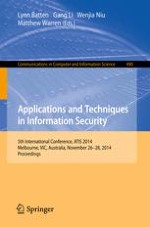2014 | Book
Applications and Techniques in Information Security
5th International Conference, ATIS 2014, Melbourne, VIC, Australia, November 26-28, 2014. Proceedings
Editors: Lynn Batten, Gang Li, Wenjia Niu, Matthew Warren
Publisher: Springer Berlin Heidelberg
Book Series : Communications in Computer and Information Science
